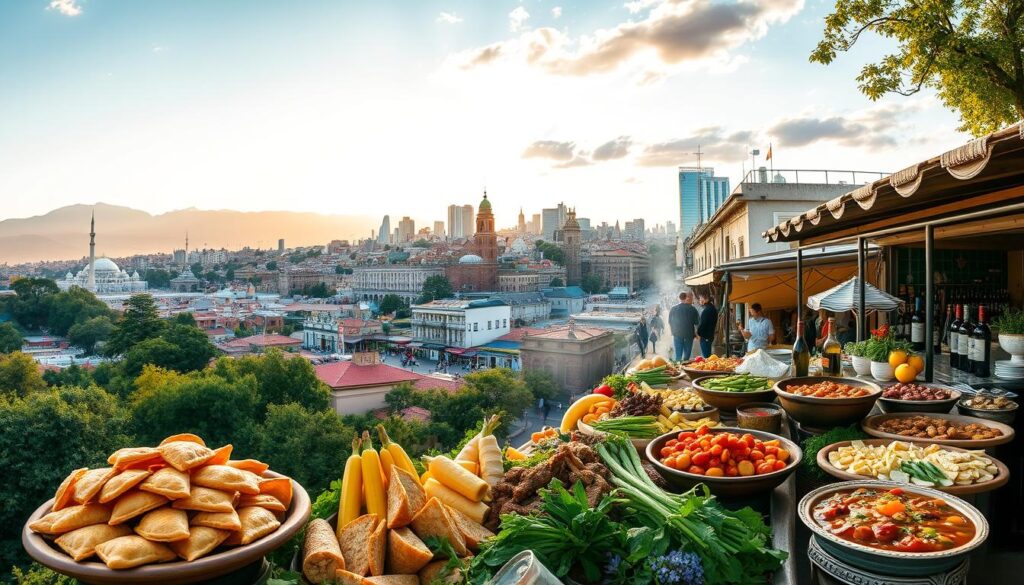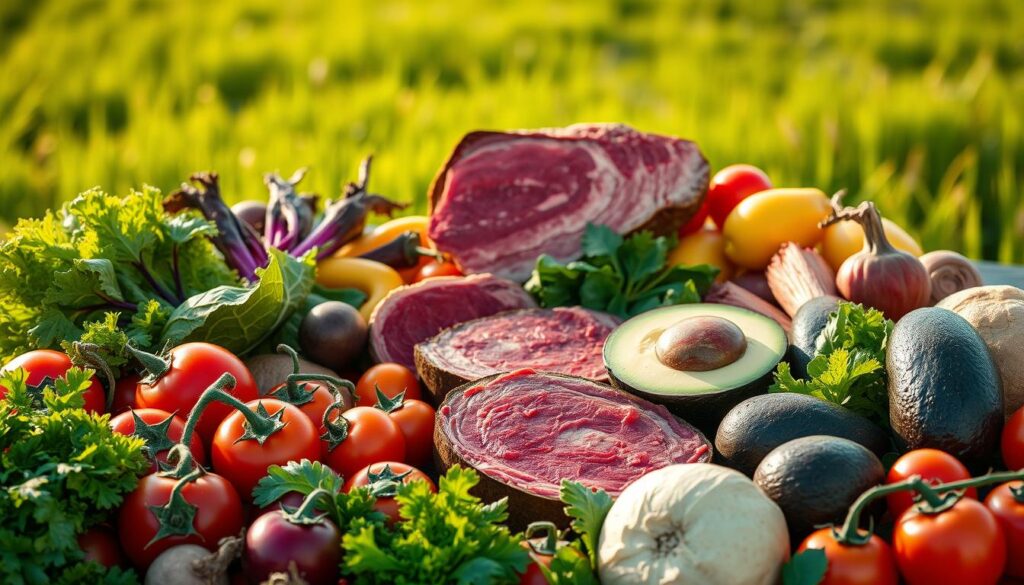Imagine stepping into a vibrant kitchen filled with the enticing aroma of grilled meats, fresh herbs, and savory spices. You feel a sense of warmth and community, as family and friends gather around the table to share delicious meals reminiscent of sun-soaked afternoons in Argentina. This is the essence of Argentinian cuisine, a rich tapestry woven from generations of culinary tradition and cultural influences. Even here in the US, you can experience the soul of this gastronomic journey through traditional dishes like empanadas or the majestic asado, crafted with skill and passion. So whether you’re a seasoned connoisseur or new to these authentic recipes, get ready to embark on a delightful exploration of flavors that will ignite your taste buds and bring a touch of Argentina right to your plate.
Key Takeaways
- Argentinian cuisine features a rich variety of influences from native cultures, Spain, and Italy.
- Grass-fed beef is a staple, with asado being a central tradition in Argentinian culture.
- Empanadas, filled with a range of ingredients, stand out as one of the most cherished dishes.
- Olive oil and traditional spices play key roles in enhancing the flavors of their culinary creations.
- Sharing meals like picada illustrates the communal aspect of Argentinian dining.
Discover the Rich History of Argentinian Cuisine
The history of argentinian cuisine is a fascinating narrative woven together by various *native cultures*, inviting you to explore its unique fusion of flavors. Understanding this culinary story offers insight into a diverse palate shaped over centuries by different influences. From indigenous ingredients to European immigrants, each contributor has left a notable mark on the country’s distinctive dishes.
Influences from Native Cultures
At the heart of argentinian cuisine, you will find foundational ingredients from *native cultures*. Staples like corn, beans, and potatoes have been essential to culinary practices long before the arrival of European settlers. These ingredients not only signify the agricultural traditions of indigenous peoples but also reflect a sense of community and identity throughout the region.
Spanish and Italian Contributions
The *culinary evolution* of Argentina underwent significant transformation with the arrival of Spanish and Italian influences. Spanish settlers introduced essential cooking techniques and ingredients such as olive oil, rice, and various meats, enriching the Argentine menu. Meanwhile, Italian immigrants brought dishes like pasta and pizza into the culinary mix, allowing for adaptations that resonate with local tastes.
The Role of Immigrants in Culinary Evolution
As *immigration* expanded in the 19th century, millions flocked to Argentina, each group contributing to the vast culinary landscape. This wave included not only Italians and Spaniards but also Central Europeans who added their own dishes and traditions. The transformation of classics like milanesa, which evolved from the Italian ‘Cotoletta alla Milanese’, exemplifies the intricate blend of flavors that characterize the modern history of argentinian cuisine.

Essential Ingredients in Argentinian Cooking
Argentinian cooking boasts a rich tapestry of flavors, anchored by its essential ingredients. The cuisine reflects a blend of influences from indigenous peoples and European settlers, creating a unique culinary identity. Each component contributes to the overall harmony and depth of Argentinian dishes, making them truly memorable.
Grass-Fed Beef: The Heart of the Cuisine
No other ingredient embodies Argentinian cuisine quite like grass-fed beef. With the country boasting a higher cattle population than its residents, meat has always played a pivotal role. On average, an Argentinian consumes 100 kg of beef annually, with some historically reaching nearly 180 kg per person in the 19th century. This premium beef is often the centerpiece of traditional barbecues, offering unparalleled flavor and tenderness.
Traditional Spices and Seasonings
Traditional spices are essential to enhance the flavors of meat and vegetable dishes alike. Commonly used spices include garlic, parsley, and pepper, all of which were introduced alongside European immigration. The widely loved chimichurri sauce, made from parsley, garlic, and vinegar, is a staple accompaniment that elevates any meat dish with its zesty profile.
Fresh Vegetables and Fruits
Fresh vegetables in Argentinian cooking add both flavor and color to meals. Common choices such as tomatoes, onions, and eggplants shine in salads and side dishes. The vibrant flavors of native crops like maize and squash further enrich the culinary experience, highlighting South America’s agricultural bounty. Seasonal fruits often find their way into desserts, providing natural sweetness and richness that complements creamy delights like dulce de leche.

Iconic Argentinian Dishes to Try
When exploring iconic Argentinian dishes, you’ll find a vibrant tapestry of flavors and traditions that highlight the country’s rich culinary heritage. Each dish tells a story, reflecting Argentina’s diverse cultural influences and its deep connection to agriculture, particularly beef. Here are three must-try dishes that capture the essence of Argentinian cuisine.
Asado: The Art of Grilling
Asado, Argentina’s national dish, showcases not only grilling techniques but also a celebration of social gatherings. Typically consisting of various cuts of meat, including beef, pork, and sausages, asado brings friends and family together. Grilled to perfection and often accompanied by chimichurri sauce, this dish emphasizes the country’s rich cattle ranching heritage.
Empanadas: A Flavorful Pastry Delight
Empanadas are savory pastries that embody the warmth of Argentinian cuisine. Filled with a variety of ingredients like ground beef, chicken, or cheese, they serve as a convenient and affordable meal. This iconic dish is particularly popular among the working class, making it a staple in many households. Enjoying empanadas offers a delightful way to experience the burst of flavors intrinsic to Argentinian fare.
Milanesa: A Crispy Comfort Food
Milanesa is a beloved dish that captures the hearts and appetites of many. Made from pounded beef or chicken, it’s coated in breadcrumbs and fried until golden brown, providing both comfort and crunch. Often served with sides like mashed potatoes or salad, milanesa is a classic lunch option that showcases the simplicity and rustic charm of Argentinian food culture.
![]()
Exploring Argentinian Barbecue Culture
Argentinian barbecue culture, or asado, goes beyond simply cooking meat. It represents a deep-rooted tradition woven into the social fabric of Argentine society. At an asado, you experience not just a meal but a communal event that nurtures relationships and cultural heritage. The types of meat used for asado and the accompanying cooking techniques are essential to understand this culinary experience.
Types of Meat Used in Asado
Asado typically features a remarkable selection of meats, showcasing the “nose-to-tail” philosophy prevalent in Argentinian cooking. Here are some commonly used meat types for asado:
- Ribeye
- Flank steak
- Choripan (chorizo sausage)
- Bondiola (marinated pork)
- Patagonian lamb
- Less common cuts such as tripe and sweetbread
This array emphasizes the diversity and richness of meat offerings during these gatherings.
Traditional Cooking Techniques
The cooking techniques for asado play a vital role in achieving tender, flavorful results. Traditionally, grilling takes place over wood fire grills and hot coals. Each asador, often a male family member, may have a preferred type of timber, which can impart unique flavors to the meat. Slow cooking is celebrated for enhancing both texture and taste, ensuring a mouthwatering experience.
Social Aspects of Argentine Barbecues
Social dining is at the heart of Argentine asados. These gatherings often commence early in the day and can extend for several hours, fostering an environment of camaraderie. Attendees typically focus on the grilled meats rather than conventional side dishes. Tradition dictates applauding the asador, highlighting respect for their skill. Accompanying the meal, local wines—particularly Malbec from Mendoza—accentuate the rich flavors of the meat.

The Importance of Wine in Argentinian Cuisine
Wine in Argentinian cuisine holds a significant place, reflecting both a rich cultural heritage and a commitment to exceptional quality. Mendoza serves as the heart of this wine culture, renowned for producing some of the best wines, particularly the Malbec varietal. This iconic grape, which constitutes approximately 40% of Argentina’s total wine output, brings a depth of flavor and complexity to any meal, enhancing the culinary experience you can savor at your table.
Malbec: Argentina’s Signature Wine
Malbec stands tall as Argentina’s flagship wine, celebrated for its bold flavors and velvety texture. Originating from France, it found its true home in the diverse terroirs of Mendoza, which contributes around 70% of the country’s total wine production. The region’s unique climate and soil conditions foster the development of exceptionally rich and fruit-forward wines. With an average price of $10 per bottle in the U.S., Malbec is not only accessible but also an ideal choice for pairing with a variety of dishes.
Pairing Wine with Traditional Dishes
Wine pairing is integral to dining in Argentina, enhancing the flavors of traditional dishes. For instance, robust red wines like Malbec perfectly complement grilled meats often featured in Asado. On the other hand, lighter, fresher white wines can accompany empanadas or seafood dishes. Many fine dining establishments in Argentina expertly curate extensive wine lists, with about 80% of them showcasing local wines to highlight Argentinian flavors. This thoughtful approach to wine pairing underscores the immersive experience of enjoying wine in Argentinian cuisine.

Savoring Argentinian Desserts
Argentinian desserts are a delightful exploration of sweet flavors, perfect for satisfying any sweet tooth. Rich in tradition, these treats showcase local ingredients and techniques that have been passed down through generations. Noteworthy among them are alfajores and the beloved dulce de leche, both integral to the country’s dessert landscape.
Alfajores: A Sweet Treat
Alfajores are delightful cookies that have captured the hearts of many. Traditionally made with two soft cookies, they are generously filled with a creamy layer of dulce de leche. Often, these sweet creations are rolled in coconut or dusted with powdered sugar. You can find variations across Argentina, integrating local flavors, and making each bite a unique experience.
Dulce de Leche: The Perfect Spread
Dulce de leche stands out as a quintessential Argentinian dessert component. This sweet treat is crafted by slowly simmering milk and sugar until it reaches a creamy, caramel-like consistency. Used as a filling, a topping, or simply enjoyed straight from the jar, dulce de leche embodies the sweet indulgence synonymous with Argentinian desserts. Its versatility allows it to complement various pastries, enhance flavors, and serve as a comforting spread for breakfast or dessert.

| Dessert | Main Ingredients | Typical Serving Style |
|---|---|---|
| Alfajores | Cookies, dulce de leche | Often sprinkled with powdered sugar or rolled in coconut |
| Dulce de Leche | Milk, sugar | Used as a filling, spread, or standalone treat |
| Chocotorta | Chocolate cookies, dulce de leche | Layered cake served cold |
| Pasta Frola | Dough, dulce de membrillo | Pie with lattice top, enjoyed as a snack or dessert |
Finding Authentic Argentinian Restaurants in the US
Exploring authentic Argentinian restaurants can be a delightful journey through the varied flavors of Argentina. The vibrant culinary scene in the United States offers numerous opportunities to savor these dishes in major cities. When searching for authentic eateries, you should pay attention to the various aspects that define restaurant authenticity.
Popular Cities for Argentinian Cuisine
Several cities stand out as hotspots for Argentinian cuisine. New York City, Los Angeles, and Miami host a multitude of authentic Argentinian restaurants that showcase the country’s culinary traditions. Each location features unique dining experiences, from casual eateries to upscale establishments, ensuring there’s something for every palate.
What to Look For in an Authentic Restaurant
When seeking authentic Argentinian cuisine, consider the following indicators of restaurant authenticity:
- Traditional Cooking Techniques: Look for restaurants using traditional methods, particularly the classic parrilla grill that emphasizes cooking over an open flame.
- Classic Dishes: Authentic Argentinian restaurants should serve iconic dishes such as asado and empanadas, showcasing the rich flavors of Argentina.
- Quality Ingredients: Restaurants that prioritize high-quality ingredients, especially grass-fed beef, reflect the true essence of Argentinian cuisine.

Cooking Argentinian Dishes at Home
Bringing the authentic flavors of Argentinian cuisine to your kitchen can be an exciting culinary adventure. By selecting the right essential cooking equipment, you can recreate beloved dishes that embody the spirit of Argentina. A grill or parrilla is vital for cooking argentinian dishes like asado, while cast-iron skillets are perfect for preparing delicious empanadas. Knowing where to start can make this experience even more enjoyable.
Essential Cooking Equipment
- Grill or Parrilla: Ideal for grilling meats and achieving that smoky flavor.
- Cast-Iron Skillets: Perfect for baking empanadas and achieving a crispy crust.
- Wooden Cutting Boards: Essential for preparing fresh vegetables and meats.
- Mixing Bowls: Necessary for preparing marinades and sauces like chimichurri.
- Meat Thermometer: Ensures perfectly cooked meats every time.
Key Recipes to Start With
- Asado: A traditional barbecue featuring various cuts of beef, best enjoyed with chimichurri sauce.
- Empanadas: Stuffed pastries that can be filled with meat, cheese, or vegetables.
- Milanesa: Breaded and fried meat cutlets, often served with mashed potatoes.
Tips for Authentic Flavor
To ensure you capture authentic flavors while cooking, focus on using high-quality ingredients. Fresh, local produce enhances each recipe’s taste. When making your own chimichurri, remember to allow the flavors to meld for at least an hour before serving. Marinating meats, such as lamb, with chimichurri for two hours prior to grilling can significantly elevate the dish’s flavor profile. Don’t forget to explore unique fillings for your empanadas for a delightful twist!

Discovering Regional Variations in Argentinian Cuisine
The vibrant tapestry of Argentinian cuisine showcases remarkable regional variations, reflecting the diverse cultural influences and geography of the country. Each region contributes its unique flavors and ingredients, resulting in a culinary map rich with tradition and innovation. When exploring northern Argentinian cuisine, you’ll find a delightful emphasis on hearty dishes that incorporate indigenous ingredients, while coastal influences manifest in the southern regions with fresh seafood and lighter fare.
Northern Argentinian Flavors
Northern Argentina boasts a variety of hearty dishes that utilize staples such as corn, potatoes, and a medley of spices. Traditional meals, like locro, a thick stew often made with beans and meats, showcase the richness of the region’s agricultural bounty. Empanadas from this area are particularly noteworthy, with variations that may include raisins or unique fillings like boiled potatoes and peas. Influences from indigenous cultures and the vibrant blend of Spanish and Andean culinary practices create an exciting dining experience.
Southern Coastal Influences
In contrast, the southern coastal regions of Argentina emphasize lighter fare and seafood, reflecting the accessibility of fresh catches from the Atlantic. Dishes often feature local fish and shellfish, which are celebrated for their unique flavors and textures. The Patagonia region is renowned for its grilled lamb, a specialty that highlights local pastoral practices. While cities like Buenos Aires may not always feature lamb prominently on menus, the growing interest in comprehensive regional cuisines means you can find authentic dishes that pay homage to the coast. This variety illustrates the ways in which Argentinian cuisine evolves to mirror its geography and cultural heritage.

The Rise of Argentinian Cuisine in Fusion Foods
The surge in popularity of Argentinian cuisine is reshaping the culinary landscape, leading to exciting developments in argentinian fusion foods. As chefs experiment with traditional recipes, they are creating innovative and creative dishes that blend the robust flavors of Argentina with various global influences. This adventurous spirit reflects a growing trend among diners seeking new experiences and flavors.
Creative Twists on Classic Dishes
Fusion restaurants are now embracing the vibrant essence of Argentinian fare, elevating classics like asado and empanadas by fusing them with international elements. Think empanadas filled with Asian-inspired ingredients or asado served with Mediterranean spices. These creative dishes not only retain the heart of Argentinian cuisine but also highlight its versatility and adaptability.
Popular Argentinian-Inspired Fusion Restaurants
You can find various fusion restaurants across the United States that creatively incorporate Argentinian-inspired menus. These establishments often offer unique takes on traditional dishes, appealing to a food-loving audience eager for new tastes. Here are a few examples of popular spots:
- Restaurants that serve fusion tacos featuring carne asada and chimichurri sauce.
- Pizza places that incorporate Argentine beef and sweet potato toppings for a unique twist.
- Gelato shops that blend classic Argentine flavors with trendy ingredients like matcha or lavender.

Celebrating Argentinian Traditions and Festivals
Argentinian traditions and culinary festivals play an integral role in the vibrant cultural landscape of the country. These events often center around communal meals, fostering a sense of togetherness and shared identity among families and friends. As you delve into the culinary significance of Argentine holidays, you’ll discover that food not only nourishes but also brings joy and unity.
Culinary Significance of Argentine Holidays
Each holiday in Argentina features unique holiday foods that reflect the nation’s rich cultural heritage. Celebrations, such as Independence Day on July 9, are marked by traditional dishes like locro, a hearty stew enjoyed on chilly Southern Hemisphere nights. During the Vendimia, or Grape Harvest Festival, local specialties and fine wines take center stage, showcasing the best of Mendoza’s vineyards.
Foods That Bring People Together
Gatherings during special occasions are often highlighted with an asado, where family and friends come together to grill various meats over an open flame. This barbecue tradition exemplifies the spirit of Argentine celebrations, merging culinary delights with social interaction. Empanadas, sold by the dozen, are another favorite, representing regional variations in styles and fillings that cater to all palates.

How to Pair Argentinian Dishes with Beverages
Enhancing your dining experience involves knowing the right pairings for Argentinian dishes with suitable beverages. A country renowned for its vibrant palate, Argentina excels in a variety of traditional drinks that complement its culinary offerings beautifully. Understanding the ideal pairings not only intensifies flavors but also enriches cultural appreciation. The following insights will guide you through popular choices in pairings that highlight the essence of Argentinian cuisine.
Traditional Drinks to Savor
In Argentina, traditional drinks play a significant role in enhancing meals. With Argentina serving more meat per capita than any other country, pairing these rich flavors with a robust red wine is a classic choice. Malbec emerges as the quintessential companion for many meat-based dishes, especially asado. Wine production in Argentina has gained international acclaim, with Reserva and Gran Reserva wines being particularly favored to accentuate the depth of grilled meats.
Exploring Yerba Mate Culture
An iconic aspect of Argentinian culture is yerba mate, a traditional drink that embodies the spirit of social connection. Served in a hollow gourd with a metal straw, yerba mate transcends mere consumption; it’s a cherished ritual fostering camaraderie among friends and family. Pairing yerba mate with lighter fare, such as picada or even pizza, creates a delightful contrast, allowing the flavors of both food and drink to shine. The rich social significance of sharing mate further enriches any meal, making it an integral part of Argentinian dining.

The Health Benefits of Argentinian Ingredients
Argentinian cuisine offers a wealth of health benefits through its ingredients, particularly with the use of grass-fed beef and fresh produce. These elements not only create delicious meals but also contribute positively to your health and well-being.
Nutritional Value of Grass-Fed Beef
Grass-fed beef stands out for its impressive nutritional value. This type of beef is renowned for being higher in omega-3 fatty acids compared to grain-fed beef, positively impacting heart health. A typical serving of grass-fed beef can provide a substantial source of protein, supporting muscle maintenance and repair. The presence of conjugated linoleic acid (CLA) in grass-fed beef is linked to various health benefits, making it a smart choice for those seeking nutritious protein alternatives.
Benefits of Fresh Produce in Argentine Cooking
Fresh produce plays a crucial role in Argentinian meals, enhancing both flavor and nutritional content. Fruits and vegetables are often incorporated into traditional dishes, providing essential vitamins and minerals necessary for overall health. The dietary fibers found in fresh produce, such as those in polenta, contribute to digestive health and help maintain stable blood sugar levels. Additionally, the vibrant colors and flavors of these ingredients make every dish appealing and satisfying.

Final Thoughts: Embracing Argentinian Cuisine
Embracing Argentinian cuisine offers you an incredible opportunity to delve into a world rich with flavors, traditions, and stories. As the highest beef-consuming nation in the world, Argentina showcases its culinary pride through beautifully prepared dishes like asado and empanadas. By choosing to experience Argentinian food, you not only indulge in delicious meals but also connect with a culture that values family and community through its dining traditions.
Why You Should Experience It
From the vibrant celebrations of national holidays centered around hearty dishes like locro to the cherished practices of gathering for weekly asados, there is a unique charm in the way Argentines appreciate their food. Engaging with these recipes enables you to share in these cultural moments, enriching your own culinary repertoire. The flavors, from tender grass-fed beef to the sweet notes of dulce de leche, invite you on a truly satisfying gastronomic journey.
Share the Joy of Argentinian Recipes with Loved Ones
Sharing recipes from this remarkable cuisine with your loved ones not only enhances your meals but also fosters connection and joy. Whether you’re whipping up classic empanadas or grilling a mouthwatering skirt steak, each dish becomes an occasion to create lasting memories with family and friends. As you explore the world of Argentinian cooking together, you create your own experiences rooted in the warmth and vibrancy of Argentinian culture.









